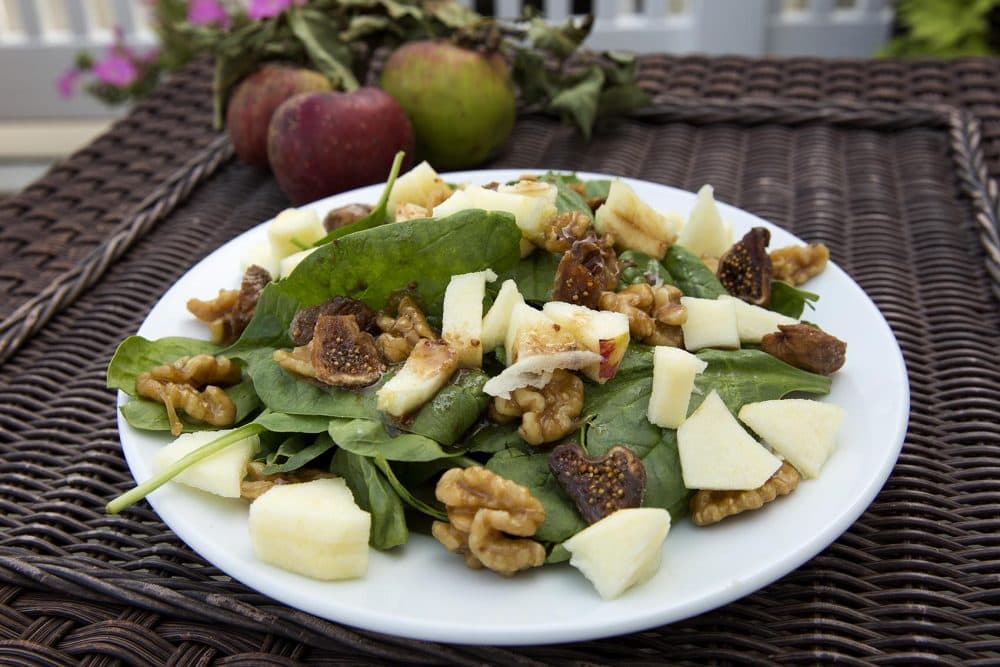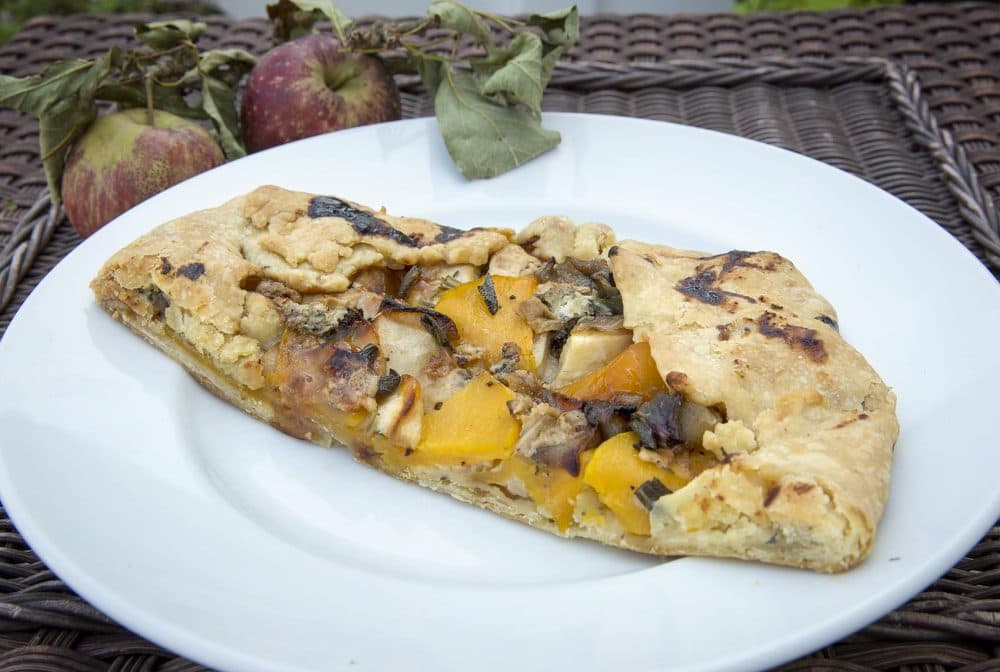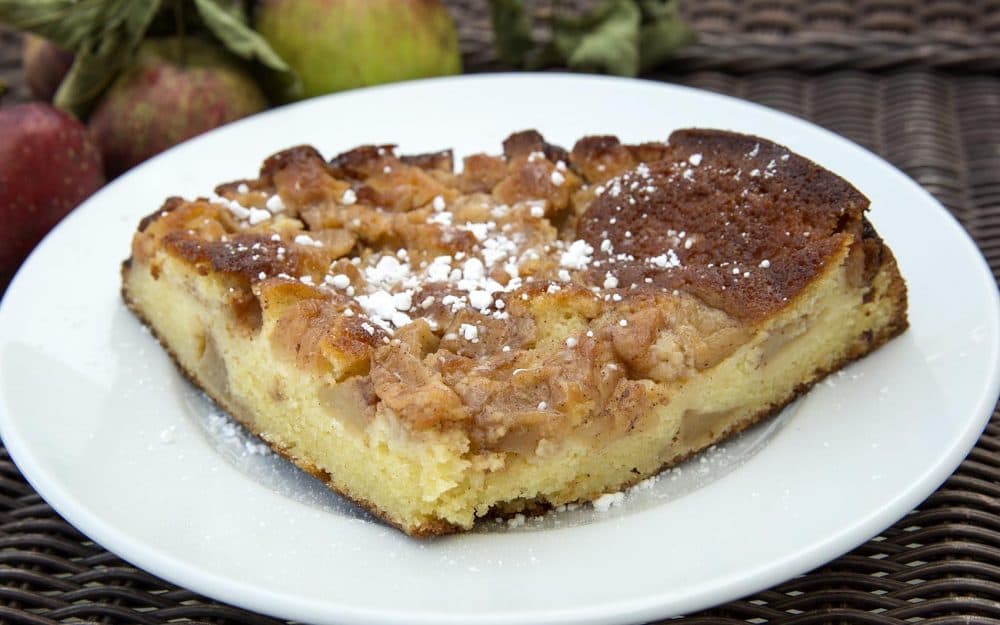Advertisement
No Slim Pickings Here: 3 Apple Dishes To Fulfill Your Autumn Wishes
Resume
It's apple season, and Here & Now resident chef Kathy Gunst wants to celebrate. She's provided a guide to a number of her favorite apple varieties, and also has three recipes that take advantage of the fruit's sweet and savory sides.
"An apple a day … "
We've all heard this saying, but what does it mean?
Apples are very good for you: They are rich in antioxidants, vitamins C and A, iron, calcium and fiber, and are considered one of the top 15 healthiest foods to eat. So have your apple a day or, during this season when they are freshest, have two.
There are over 2,500 varieties of apples grown in the U.S., not to mention the countless number of heirlooms — or antique apples — that grow in smaller numbers on orchards dotted across the country. Heirlooms are worth seeking out at orchards and farmers markets.
14 Apple Varieties
Here's a guide to just a few commonly available apple varieties in the U.S.:
- Cortland: These come from New York and are over 100 years old. With a yellow-green skin with red streaks, they tend to be large apples and are quite tart and tender. They turn brown a bit slower than other varieties making them ideal for recipes like salads, or dishes where the apple is used raw.
- Empire: This apple variety was discovered in the Empire State of New York in the 1960s. A medium-sized red apple, Empires are a cross between Red Delicious apples and McIntosh. They are crisp and juicy, with a sweet and simultaneously tart flavor. They have a creamy white flesh and are an all-purpose apple.
- Fuji: These came from Japan in the 1930s, are named after Mount Fuji and were introduced to the U.S. in the '80s. They are a cross between two apples: the Red Delicious and Virginia Ralls Genet (also called Rawls Jennet). A sweet apple with a slight lemony, honey flavor, they can be used in cooking — though they do tend to cook down and should be cut in thicker than normal slices — or eaten as a snack.
- Ginger Gold: This variety boasts a crisp, cream-colored flesh and a sweet, mild, tart flavor. Some find them to be spicy. They are great to eat raw or cook with, as they don't tend to brown quickly.
- Golden Delicious: Buttery with a light honey flavors, these apples are good baked or raw. They are quite mild, but also have a sweet flavor.
- Granny Smith: These hail from Australia and were discovered in the late 1800s. Their distinctive bright-green flesh is quite tart and they are considered an all-purpose apple with a crunchy texture. They have a high level of acidity and are a good baking apple because they hold their shape well, but are also delicious as a snacking apple.
- Honeycrisp: Mild, crisp, juicy apples with a scarlet color over a yellow background. Discovered in 1960 as part of the University of Minnesota's apple breeding program, some find that they taste like freshly made apple cider. They have a great balance of sweetness and acidity.
- Jazz: A blend of many flavors — a bit like jazz music — and have a sweetness and beautiful aroma. Round with a rosy-red skin, often with yellow or orange streaks, these firm apples are low acid and excellent for cooking and eating.
- Jonagold: A blend of Jonathan and Golden Delicious varieties. A New York native, they tend to be large apples, have a honey flavor and are tart, crisp and juicy. Jonagold can be used for cooking or eaten raw.
- Macoun: Delicious raw and quite sweet. A favorite for making cider or applesauce. They are a medium-sized apple, with a deep-red skin and a creamy white tender flesh. Some think they taste vaguely of berries.
- McIntosh: Better known as "Macs," these are very popular in the U.S. and particularly New England. They were said to be discovered in 1811 by John McIntosh and have a deep-red color with a green blush. Known for their juicy, tangy, spicy flavor, this apple can be used for cooking or for snacking out of hand.
- Mutsu: One of my personal favorites. They have a Japanese heritage and are often also called Crispin. Sweet, thoroughly refreshing and exceptionally juicy, they can be used in cooking and eating out of hand. There is the Green Mutsu (firm flesh, crisp, juicy) as well as the Red Mutsu, which is medium- to large-sized.
- Paula Red: Sweet and tart and can be used for cooking or eating raw. They hail from Michigan and tend to arrive in markets early in the apple season. They look like McIntosh with a white flesh that is sweet, tart and berrylike.
- Red Delicious: The most popular American apples. They come from Iowa and were first harvested in the 1870s. Sweet, juicy and crisp, though many cooks find them boring. A one-note apple? These are best eaten raw and not used in cooking.

Apple, Butternut Squash, Caramelized Onion, Blue Cheese And Sage Croustade
The flavors of fall come together in this beautiful, savory croustade (rustic tart). Make the pastry a few hours ahead of time, or a day before or weeks before and freeze.
The squash needs to be prebaked and the onions caramelized, and the rest all comes together pretty quickly. Serves 4 to 6.
Sage Pastry Ingredients
- 2 cups flour
- Pinch salt
- 1 1/2 sticks butter, chilled and cut into small pieces
- 1 tablespoon finely chopped fresh sage (optional)
- About 1/4 cup ice cold water or more
Filling Ingredients
- About 1 pound butternut squash, peeled and thinly sliced
- 2 tablespoons olive oil
- 1 medium red onion, thinly sliced
- 2 large or 3 medium apples, peeled and thinly sliced
- Salt and freshly ground black pepper
- 1 tablespoon fresh sage, finely chopped
- 1 cup crumbled blue cheese
- 1/4 cup apple cider
Instructions
- In the container of a food processor whirl the flour and salt. Add the butter and sage and pulse about 15 times or until the butter looks like coarse cornmeal. With the motor on, add only enough water so that the dough comes together and pulls away from the sides of the machine. Remove and place in parchment paper or plastic wrap and refrigerate for at least an hour, or up to 24 hours. The pastry can also be frozen for up to three months.
- Prepare the filling: Heat the oven to 350 degrees. Place the butternut squash slices on a cookie sheet lined with parchment paper. Drizzle 1 tablespoon of the olive oil on top and season with salt and pepper. Bake on the middle shelf for about 12 minutes or until the slices are almost tender. Remove and cool.
- Meanwhile, in a medium skillet, heat the remaining tablespoon of oil over medium heat. Add the onions, salt and pepper and cook, stirring for about 15 minutes, or until very soft. Reduce the heat if they begin to brown; remove, cool and set aside.
- Heat the oven to 400 degrees.
- Remove the pastry from the refrigerator. Roll it out into a 12-inch circle. Place on a flat cookie or baking sheet.
- Alternating slices, make an outer circle of squash and apples, leaving a 1 1/2-inch border. Make another circle of squash and apple in the center. Spoon the cooked onions over the surface of the squash and apples. Season with salt and pepper and sprinkle with the sage and then the blue cheese. Spoon the cider on top of the squash and apples. Fold the border over the filling, leaving the center open.
- Bake on the middle shelf for about 25 to 35 minutes, or until the pastry is golden brown, the apples are tender and the cheese melted. Serve hot or at room temperature.

Apple Cake
This extremely simple and satisfying apple cake is adapted from "Full Moon Suppers at Salt Water Farm," by Annemarie Ahearn (Roost Books).
Annemarie's recipe is for peach cake, and after a summer of making this cake with peaches, I decided to try sauteing apples with fall spices and a touch of maple syrup and it worked beautifully. I also added buttermilk instead of using all heavy cream for a lighter touch. Serve with whipped cream if you like.
Cake Ingredients
- 1 cup flour
- 1/2 cup almond flour
- 1/2 teaspoon sea salt
- 2 teaspoons baking powder
- 9 tablespoons butter, softened at room temperature
- 3/4 cup sugar
- 3 large eggs
- 1/2 cup heavy cream plus 1/4 cup buttermilk
Apples Ingredients
- 1 tablespoon butter
- 3 large apples, peeled and cut into 1-inch pieces
- 1/2 teaspoon ground ginger
- 1/2 teaspoon ground cinnamon
- 2 1/2 tablespoons maple syrup
Instructions
- Heat the oven to 375 degrees. Thoroughly grease an 8-inch springform pan with butter and set aside.
- In a medium bowl combine the flour, almond flour, salt and baking powder. With a stand mixer fitted with the paddle attachment, whip together the butter and sugar until light. Add the eggs one at a time, whipping well. Mix in one-third of the dry ingredients and the cream/buttermilk, scraping the sides of the bowl in between additions.
- In a large skillet melt the butter over moderate heat. Add the apples, ginger and cinnamon and cook, stirring, for two minutes. Raise the heat to moderately high, add the maple syrup and cook for two minutes, or until bubbling and thickened. Remove and cool.
- Pour the batter into the prepared cake pan. Place the apples on top, spreading them out evenly. Bake on the middle shelf for one hour or until a toothpick inserted in the center comes out clean. Allow to cool on a rack and serve at room temperature.
Spinach Salad With Apples, Figs And Maple-Caramelized Walnuts With A Grainy Mustard-Apple Cider Vinaigrette
Tender baby spinach is mixed with peeled, chopped apples, meaty figs and walnut halves that are caramelized with maple syrup. The vinaigrette uses apple cider and grainy mustard to bring the whole salad together.
You could also sprinkle blue cheese or goat cheese on top. Serves 2 to 4.
Salad Ingredients
- 1 1/2 tablespoons butter
- 1 cup walnut halves
- Salt and freshly ground black pepper
- 1/4 cup maple syrup
- 2 cups baby spinach
- 2 apples, peeled and chopped into 1/2-inch pieces
- 1 cup dried figs, cut into 1/2-inch pieces
- 1/2 cup crumbled blue cheese, goat cheese or feta (optional)
Apple Cider Dressing Ingredients
- 1 1/2 tablespoons grainy mustard or Dijon-style mustard
- Salt and freshly ground black pepper
- 1/4 cup apple cider
- 3 tablespoons olive oil
- 1 1/2 tablespoons white wine vinegar
Instructions
- In a medium skillet heat the butter over moderate heat. Add the walnuts and cook for two minutes. Add the maple syrup, salt and pepper and cook for two to three minutes, or until the syrup has thickened. Spread the walnuts on a sheet of wax or parchment paper so they don't clump.
- Arrange the spinach in a bowl or on a serving plate. Arrange the apples, figs, walnuts and cheese (if using) on top.
- Make the dressing: In a small bowl mix the mustard, salt, pepper and cider. Add the oil and vinegar and taste for seasoning. Serve a few tablespoons of dressing on top and the rest on the side.
This segment aired on October 5, 2017.
